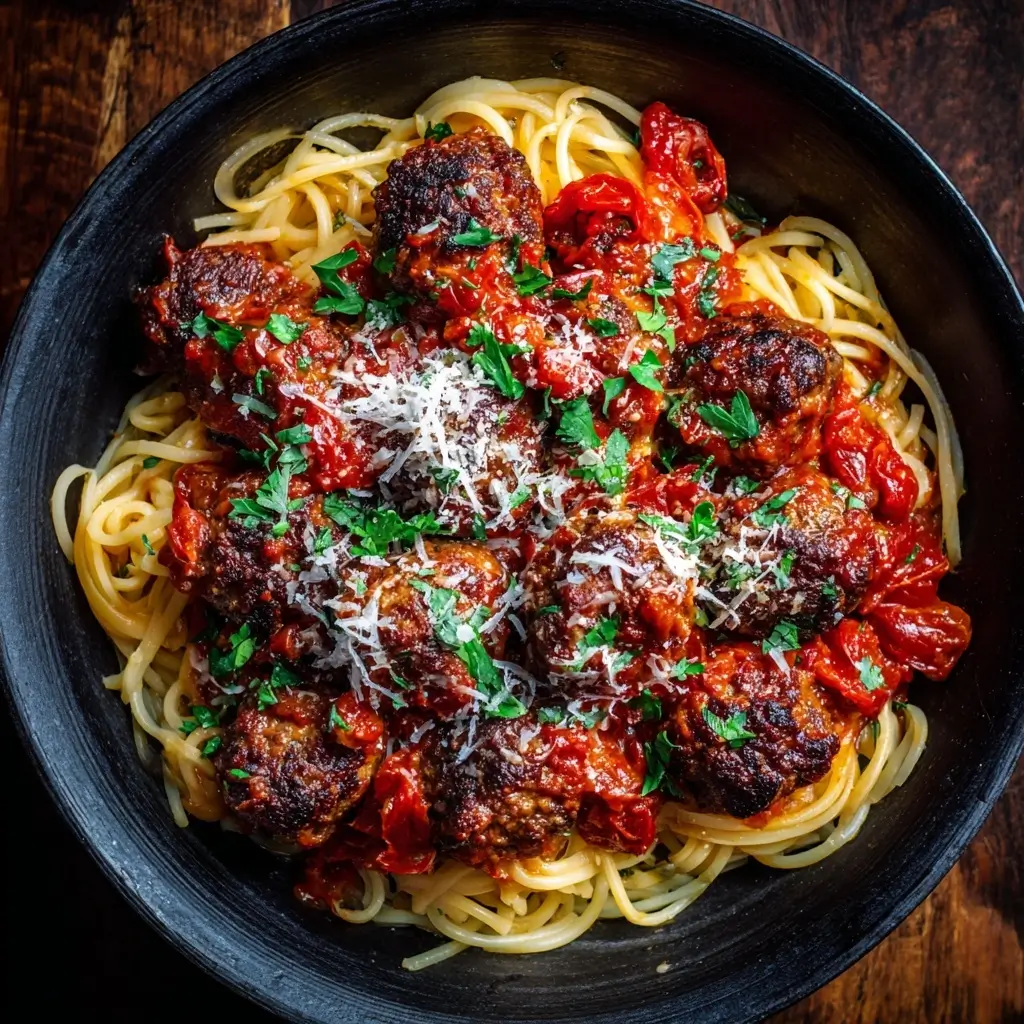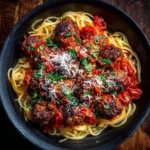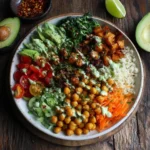Introduction
Vegan Spaghetti & Meatballs is a comforting, hearty, and entirely plant-based twist on the beloved Italian-American classic. Perfect for weeknight dinners or weekend family meals, this dish brings together tender, protein-rich vegan meatballs with perfectly al dente spaghetti and a rich, savory tomato sauce. Whether you’re committed to a vegan lifestyle or simply looking to incorporate more plant-based meals into your diet, this recipe delivers on flavor, texture, and satisfaction—without a trace of animal products. With its bold seasonings, wholesome ingredients, and nostalgic appeal, Vegan Spaghetti & Meatballs proves that compassionate eating can be both delicious and deeply satisfying.
The History
The origins of spaghetti and meatballs trace back to Italian immigration in the United States during the late 19th and early 20th centuries. While traditional Italian cuisine typically serves pasta and meat as separate courses, Italian-Americans began combining them, creating what we now know as spaghetti and meatballs. The dish became a symbol of home-cooked comfort, often made with ground beef, pork, or veal mixed with breadcrumbs, herbs, and Parmesan cheese, served over long strands of spaghetti with marinara sauce.
As dietary preferences evolved and plant-based eating gained popularity, chefs and home cooks began reimagining the classic with cruelty-free alternatives. Vegan versions emerged using legumes, mushrooms, lentils, tofu, and plant-based proteins to replicate the umami-rich, chewy texture of meat. Over time, innovations in food technology introduced commercial vegan grounds and binders like flaxseed meal and vital wheat gluten, making it easier than ever to create meatless meatballs that satisfy even the most discerning palates. Today, Vegan Spaghetti & Meatballs stands as a modern homage to culinary tradition—respecting heritage while embracing sustainability, health, and inclusivity.
Ingredients Breakdown
The success of Vegan Spaghetti & Meatballs lies in the thoughtful selection and balance of ingredients that mimic the savory depth and hearty texture of traditional meatballs—all while staying 100% plant-based. Here’s a detailed breakdown:
- Lentils (Cooked): Brown or green lentils provide a meaty texture and are rich in protein and fiber. They act as the primary base for the meatballs, offering structure and moisture retention.
- Mushrooms (Cremini or Button): Finely chopped and sautéed, mushrooms contribute umami flavor and a juicy, tender bite. Their natural glutamates enhance savoriness without relying on animal products.
- Oats (Rolled or Quick): Used as a binder and extender, oats help hold the meatballs together while adding whole-grain nutrition and a subtle nuttiness.
- Flaxseed Meal: Mixed with water, flaxseed forms a gel-like “flax egg” that replaces eggs as a binding agent, crucial for holding the mixture together during cooking.
- Onion and Garlic: Sautéed until fragrant, these aromatics build the foundational flavor profile, adding sweetness and pungency essential to any good meatball.
- Fresh Herbs (Parsley, Oregano, Basil): These herbs bring brightness and authenticity, echoing the Mediterranean roots of Italian cuisine.
- Nutritional Yeast: A vegan staple, nutritional yeast adds a cheesy, nutty depth that mimics Parmesan, enhancing overall flavor complexity.
- Tomato Paste: Concentrated tomato paste intensifies the savory richness and helps bind the mixture while contributing to browning.
- Spices (Paprika, Fennel Seeds, Black Pepper): Smoked paprika adds warmth, fennel seeds give a sausage-like aroma, and black pepper provides gentle heat.
- Whole Wheat Bread Crumbs or Panko (Vegan): Added for texture and absorbency, they help achieve a firm yet tender bite.
- Olive Oil: Used for sautéing and brushing, olive oil enhances mouthfeel and promotes golden browning.
- Marinara Sauce: Choose a high-quality store-bought or homemade version made with tomatoes, garlic, onions, herbs, and no added sugar or animal derivatives.
- Salt and Pepper: Essential for seasoning and balancing flavors throughout.
- Spaghetti (Durum Wheat or Gluten-Free): The classic pasta partner; opt for whole grain or legume-based noodles for extra nutrition.
- Optional Add-Ins: Chopped walnuts or sunflower seeds for crunch, miso paste for umami, or vital wheat gluten for chewier texture.
Step-by-Step Recipe
- Prepare the Lentils: If not using canned, cook 1 cup dry brown or green lentils in 3 cups of water until tender but not mushy (about 25–30 minutes). Drain and set aside to cool slightly. You’ll need about 2 cups cooked lentils.
- Sauté the Aromatics: Heat 2 tablespoons olive oil in a skillet over medium heat. Add 1 finely diced onion and cook until translucent (5–7 minutes). Add 4 minced garlic cloves and cook for another minute until fragrant.
- Cook the Mushrooms: Add 2 cups finely chopped mushrooms to the skillet. Cook for 8–10 minutes, stirring occasionally, until they release their moisture and begin to brown. This step concentrates flavor and removes excess water. Remove from heat and let cool slightly.
- Make the Flax Egg: In a small bowl, mix 2 tablespoons ground flaxseed with 5 tablespoons warm water. Let sit for 10 minutes until thick and gelatinous.
- Combine Meatball Mixture: In a large mixing bowl, add the cooked lentils, sautéed mushroom-onion mix, 1 cup rolled oats, 1/2 cup bread crumbs, 1/4 cup nutritional yeast, 2 tablespoons tomato paste, 1 teaspoon smoked paprika, 1 teaspoon dried oregano, 1 teaspoon dried basil, 1/2 teaspoon fennel seeds (crushed), 1/4 cup fresh parsley (chopped), salt, and pepper. Pour in the prepared flax egg. Mix thoroughly with your hands or a spoon until well combined and sticky.
- Form the Meatballs: Preheat oven to 375°F (190°C). Line a baking sheet with parchment paper. Scoop about 2 tablespoons of mixture and roll into balls (you should get 18–24). Place on the tray, leaving space between each. For firmer meatballs, chill the mixture for 20–30 minutes before shaping.
- Bake the Meatballs: Brush lightly with olive oil. Bake for 25–30 minutes, flipping halfway through, until golden brown and firm to the touch.
- Cook the Spaghetti: While meatballs bake, bring a large pot of salted water to a boil. Add 12 oz (340g) spaghetti and cook according to package instructions until al dente. Drain, reserving 1/2 cup pasta water, and toss with a drizzle of olive oil to prevent sticking.
- Heat the Sauce: In a large saucepan, warm 3–4 cups of marinara sauce over medium heat. Gently add the baked meatballs and simmer for 5–10 minutes to infuse flavor.
- Assemble: Serve the spaghetti on plates or bowls, top with several meatballs and plenty of sauce. Garnish with fresh basil, red pepper flakes, or vegan Parmesan if desired.
Tips
- Texture is Key: Avoid over-mixing the meatball mixture, which can make it dense. Aim for a cohesive but slightly coarse texture.
- Dry Ingredients: Ensure lentils and mushrooms are well-drained and sautéed thoroughly to prevent soggy meatballs.
- Chill Before Baking: Refrigerating the shaped meatballs for 20–30 minutes helps them hold their shape better during baking.
- No-Fail Binding: If the mixture feels too wet, add more bread crumbs or oats. If too dry, add a splash of vegetable broth or another flax egg.
- Browning Matters: For deeper flavor, pan-sear the meatballs before baking or finish them under the broiler for 2–3 minutes.
- Sauce Simmer: Letting the meatballs simmer in the sauce allows them to absorb flavor and become juicier.
- Pasta Water Magic: When tossing spaghetti with sauce, use reserved starchy pasta water to help the sauce cling better.
- Batch Cooking: This recipe freezes beautifully. Freeze uncooked or cooked meatballs on a tray, then transfer to bags for up to 3 months.
- Oil-Free Option: Skip brushing with oil and bake on a non-stick mat. Or use a light mist of olive oil spray.
- Uniform Size: Use a cookie scoop for evenly sized meatballs that cook uniformly.
Variations and Customizations
Vegan Spaghetti & Meatballs is incredibly adaptable to different tastes, dietary needs, and ingredient availability. Here are some creative twists:
- Walnut & Lentil Meatballs: Replace half the lentils with finely ground walnuts for a richer, more decadent texture and added omega-3s.
- Mushroom & Walnut Base: Use only mushrooms and walnuts as the foundation for a grain-free, paleo-inspired version (bind with flax and chia).
- Chickpea “Meatballs”: Mash chickpeas instead of lentils for a different flavor profile and lighter color.
- Thai-Inspired: Swap Italian herbs for lemongrass, ginger, soy sauce, and cilantro. Serve over rice noodles with a peanut-lime sauce.
- Mexican Style: Add cumin, chili powder, and corn to the mixture. Serve with black bean sauce and tortillas or over enchilada-style spaghetti.
- Gluten-Free: Use certified gluten-free oats and bread crumbs, and ensure all other ingredients are GF-safe.
- Protein Boost: Incorporate 1/2 cup vital wheat gluten (seitan base) for a chewier, higher-protein meatball.
- Smoky BBQ Version: Mix in liquid smoke and smoked paprika, then coat baked meatballs in barbecue sauce.
- Stuffed Meatballs: Hide a cube of vegan mozzarella in the center for a melty surprise.
- Sheet Pan Dinner: Arrange spaghetti (pre-cooked) on a sheet pan, top with meatballs and sauce, and broil briefly for a crispy top.
- Zucchini Noodles: Serve over spiralized zucchini or sweet potato noodles for a low-carb alternative.
- Pre-Made Options: Use store-bought vegan meatballs (like Beyond or Ikea’s veggie balls) for a quick version—just heat and serve.
Health Considerations and Nutritional Value
Vegan Spaghetti & Meatballs offers numerous health advantages over its traditional counterpart, primarily due to the absence of saturated animal fats and cholesterol, along with an abundance of fiber, antioxidants, and phytonutrients.
Nutritional Highlights (per serving, approx. 1/6 of recipe):
- Calories: ~450–500 kcal
- Protein: 18–22g (from lentils, oats, nutritional yeast, and mushrooms)
- Fiber: 12–15g (supports digestion and satiety)
- Fat: 12–16g (mostly heart-healthy monounsaturated fats from olive oil and nuts)
- Carbohydrates: 70–80g (complex carbs from whole grains and legumes)
- Iron: 4–6mg (enhanced absorption when paired with vitamin C-rich tomato sauce)
- Folate, Magnesium, Potassium: Abundant from lentils and vegetables
- Vitamin B12: Not naturally present; consider pairing with fortified foods or supplements if needed.
Health Benefits:
- Heart Health: Plant-based diets are linked to lower blood pressure, reduced LDL cholesterol, and decreased risk of cardiovascular disease.
- Weight Management: High fiber and protein content promote fullness and reduce overeating.
- Blood Sugar Control: Low glycemic index ingredients help maintain stable energy levels, beneficial for diabetics.
- Gut Health: Fiber acts as a prebiotic, feeding beneficial gut bacteria.
- Inflammation Reduction: Antioxidants from tomatoes, garlic, and herbs combat oxidative stress.
Considerations:
- Monitor sodium if using canned lentils or store-bought sauce; opt for low-sodium versions.
- Ensure adequate vitamin B12 and D intake through fortified foods or supplements on a long-term vegan diet.
- Those with gluten sensitivity must use certified gluten-free ingredients.
- Portion control is advised if managing calorie intake, though this meal is naturally filling.
Ingredients
- 2 cups cooked brown or green lentils (about 1 cup dry)
- 2 tbsp olive oil (plus extra for brushing)
- 1 medium yellow onion, finely diced
- 4 garlic cloves, minced
- 2 cups cremini or button mushrooms, finely chopped
- 2 tbsp ground flaxseed + 5 tbsp warm water (flax egg)
- 1 cup rolled oats (gluten-free if needed)
- 1/2 cup whole wheat or vegan bread crumbs
- 1/4 cup nutritional yeast
- 2 tbsp tomato paste
- 1 tsp smoked paprika
- 1 tsp dried oregano
- 1 tsp dried basil
- 1/2 tsp crushed fennel seeds
- 1/4 cup fresh parsley, chopped
- 1 tsp sea salt (or to taste)
- Freshly ground black pepper, to taste
- 12 oz (340g) spaghetti (whole wheat, durum, or gluten-free)
- 3–4 cups marinara sauce (homemade or store-bought, vegan)
- Optional: vegan Parmesan, red pepper flakes, fresh basil for garnish
Directions
- Cook lentils if not using canned. Drain and set aside.
- Heat olive oil in a skillet over medium heat. Sauté onion until soft (5–7 min). Add garlic, cook 1 min. Add mushrooms, cook 8–10 min until browned. Remove from heat.
- Preheat oven to 375°F (190°C). Line a baking sheet with parchment paper.
- Prepare flax egg: Mix flaxseed and water; let sit 10 min.
- In a large bowl, combine lentils, mushroom mixture, oats, bread crumbs, nutritional yeast, tomato paste, spices, herbs, salt, pepper, and flax egg. Mix until sticky and well blended.
- Roll into 1.5-inch balls (18–24 total). Place on baking sheet. Optional: Chill 20–30 min for firmer texture.
- Brush meatballs lightly with olive oil. Bake 25–30 min, flipping halfway, until golden and firm.
- While meatballs bake, cook spaghetti in salted boiling water until al dente. Drain, reserving 1/2 cup pasta water.
- Warm marinara sauce in a large pan. Gently add baked meatballs and simmer 5–10 min.
- Toss spaghetti with a bit of sauce and reserved pasta water. Divide among plates.
- Top with meatballs and extra sauce. Garnish with fresh basil, red pepper flakes, or vegan Parmesan.
- Serve immediately and enjoy!
FAQ
Can I make these meatballs ahead of time?
Yes! Prepare and shape the meatballs up to 2 days in advance and refrigerate, or freeze them raw or cooked for up to 3 months. Reheat in sauce or oven.
Can I fry the meatballs instead of baking?
Absolutely. Pan-fry in a little oil over medium heat, turning gently, until browned on all sides (about 8–10 minutes). Be careful—they’re more delicate than meat-based balls.
Why are my meatballs falling apart?
This usually happens due to excess moisture or insufficient binder. Make sure mushrooms are well-sautéed, lentils are drained, and you’ve used enough oats or bread crumbs. Chilling before baking also helps.
Are these gluten-free?
They can be! Use certified gluten-free oats, bread crumbs, and ensure your spaghetti and sauce are GF. Check all labels carefully.
Can I use canned lentils?
Yes! Drain and rinse 15-oz (400g) canned lentils. Pat dry to remove excess moisture for better texture.
What can I substitute for flaxseed?
Use chia seeds (same ratio) or commercial egg replacer. Unsweetened applesauce works in a pinch but may yield softer results.
How do I store leftovers?
Keep in an airtight container in the fridge for up to 4 days. Reheat in sauce on the stove or microwave.
Can I cook the meatballs in the sauce?
Yes, but they may break apart. It’s best to bake or pan-sear first for structure, then simmer in sauce to absorb flavor.
Is this kid-friendly?
Definitely! Many children love this version, especially when served with familiar spaghetti and sauce. Try making mini meatballs for fun.
Can I use a food processor?
Yes, pulse mushrooms, onions, and garlic for faster prep, but avoid over-processing lentils to maintain texture.
Summary
Vegan Spaghetti & Meatballs is a nourishing, flavorful, and entirely plant-based reinvention of a timeless classic, perfect for cozy dinners and family gatherings. Packed with protein, fiber, and rich umami taste, this dish proves that going vegan doesn’t mean sacrificing comfort or satisfaction.










